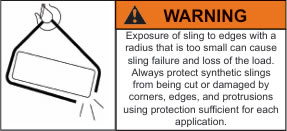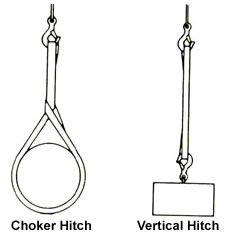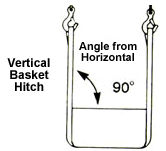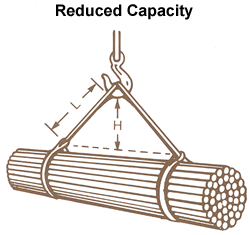
 |
ENGINEERED
STEEL PRODUCTS |
| Priced
Full Line Products Catalog |
20
Technology Way • West Greenwich, RI 02817
Toll free:(800) 421-0314 • In RI:(401) 272-4570 • Fax:(401)
421-5679 |
 |
|
|
 |
Back to Product Category
TUFLEX
ENDLESS ROUNDSLINGS |
|
|
|
|
|
Tuflex
Endless (EN)
The Most Versatile Tuflex Roundsling |
|
|
 |
|
|
|
|
| Features,
Advantages and Benefits |
|
|
|
|
|
|
| Maintains
all the basic Tuflex features plus.... |
|
|
|
|
|
|
| Promotes
Safety |
|
|
|
|
|
|
 Load stability and balance can be achieved by spreading sling Load stability and balance can be achieved by spreading sling
legs. |
|
|
|
|
|
|
| Saves
Money |
|
|
|
|
|
|
 Wear points can be shifted to extend sling life. Wear points can be shifted to extend sling life. |
|
|
|
|
|
|
 The most flexible style of sling. The most flexible style of sling. |
|
|
 Individual slings can be attached together using appropriate Individual slings can be attached together using appropriate
hardware (see photo). |
|
|
|
|
|
|
|
 |
|
|
|
|
|
|
|
|
|
TUFLEX
ENDLESS ROUNDLSINGS |
Part
No. |
Color |
Rated
Capacity* (lbs.) |
Min.
Length
(ft.) |
Approximate
Measurements |
Vertical
 |
Choker
 |
Basket
@90°
 |
Basket
@45°
 |
Wt.
(lbs./ft.) |
Body
Dia.
Relaxed
(in.) |
Body
Width
@ Load
(in.) |
Minimum
Hardware
Dia.**
(in.) |
| EN30 |
Purple |
|
2,600 |
2,100 |
5,200 |
3,600 |
1.5 |
0.20 |
0.63 |
1.00 |
0.44 |
| EN60 |
Green |
|
5,300 |
4,200 |
10,600 |
7,400 |
1.5 |
0.30 |
0.88 |
1.38 |
0.63 |
| EN90 |
Yellow |
|
8,400 |
6,700 |
16,800 |
11,800 |
3.00 |
0.52 |
1.13 |
1.75 |
0.75 |
| EN120 |
Tan |
|
10,600 |
8,500 |
21,200 |
14,000 |
3.00 |
0.60 |
1.13 |
1.88 |
0.88 |
| EN150 |
Red |
|
13,200 |
10,600 |
26,400 |
18,000 |
3.00 |
0.76 |
1.38 |
2.00 |
1.00 |
| EN180 |
White |
|
16,800 |
13,400 |
33,600 |
23,000 |
3.00 |
0.87 |
1.38 |
2.13 |
1.13 |
| EN240 |
Blue |
|
21,200 |
17,000 |
42,400 |
29,000 |
3.00 |
1.10 |
1.75 |
2.63 |
1.19 |
| EN360 |
Grey |
|
31,000 |
24,800 |
62,000 |
43,000 |
3.00 |
1.70 |
2.25 |
3.25 |
1.50 |
| EN600 |
Brown |
|
53,000 |
42,400 |
106,000 |
74,000 |
8.00 |
2.90 |
2.75 |
4.00 |
2.00 |
| EN800 |
Olive |
|
66,000 |
52,800 |
132,000 |
93,000 |
8.00 |
3.40 |
3.13 |
4.63 |
2.13 |
| EN1000 |
Black |
|
90,000 |
72,000 |
180,000 |
127,000 |
8.00 |
4.40 |
3.63 |
5.25 |
2.50 |
|
| **
This is the minimum recommended diameter for the connection hardware to
be used for a vertical hitch. |
|
|
 |
|
Order
Online, by Phone, or by E-Mail |
|
|
|
~ Add
items to your online shopping cart ~
Click a Price of the item you wish to purchase. |
|
|
*
Contact Us For Special Lengths* |
Part
No. |
Color |
Rated
Capacity* (lbs.) |
PRICE |
Vertical
 |
Choker
 |
Basket
@90°
 |
Basket
@45°
 |
3' |
4' |
6' |
8' |
| EN30 |
Purple |
|
2,600 |
2,100 |
5,200 |
3,600 |
|
|
|
|
| EN60 |
Green |
|
5,300 |
4,200 |
10,600 |
7,400 |
|
|
|
|
| EN90 |
Yellow |
|
8,400 |
6,700 |
16,800 |
11,800 |
|
|
|
|
| EN120 |
Tan |
|
10,600 |
8,500 |
21,200 |
14,000 |
|
|
|
|
| EN150 |
Red |
|
13,200 |
10,600 |
26,400 |
18,000 |
|
|
|
|
| EN180 |
White |
|
16,800 |
13,400 |
33,600 |
23,000 |
|
|
|
|
| EN240 |
Blue |
|
21,200 |
17,000 |
42,400 |
29,000 |
|
|
|
|
| EN360 |
Grey |
|
31,000 |
24,800 |
62,000 |
43,000 |
|
|
|
|
| EN600 |
Brown |
|
53,000 |
42,400 |
106,000 |
74,000 |
NA |
NA |
NA |
|
| EN800 |
Olive |
|
66,000 |
52,800 |
132,000 |
93,000 |
NA |
NA |
NA |
|
| EN1000 |
Black |
|
90,000 |
72,000 |
180,000 |
127,000 |
NA |
NA |
NA |
|
|
|
| * |
|
|
Always
protect roundslings from corners, edges, or protrusions. Refer to the Sling
Protection section
below to choose the right protection product for your lift. |
 |
|
|
|
|
|
|
|
Sling
Protection |
|
CUT
AND WEAR PROTECTION |
|
|
|
|
|
| Selection
of Sling Protection Products |
|
 |
|
Sling
protection products need to be used in applications where sling
damage may occur. Cutting of synthetic slings during use is the number
one cause of sling accidents. A variety of factors influence sling
protection performance. Since no material is fully cut proof, a qualified
person must select materials and methods that adequately protect
slings from edges or surfaces. We can assist customers with their
product selections. |
|
|
|
|
|
|
|
| Cut
Protection versus Wear Protection |
|
|
Our
sling protection products are divided into two categories, Cut Protection
and Wear Protection. Cut Protection
Products are designed to improve workplace safety. When placed between slings
and edges, cut protection products
act as a buffer to prevent sling cutting and to reduce bearing pressure
levels at contact areas. Wear protection
products serve to extend sling life by reducing abrasive wear and prevent
marring of the load surfaces.
The following table provides comparative sling protection performance for
standard products. |
|
|
 |
Performance
Rating: The bar graphs shown above reflect the comparative performance
of Our Cut Protection
products against commonly used loose and sewn-on types of Wear Protection
products.
Test Lift Qualification: To validate the suitability of sling protection
products for each application, always
complete one or more test lifts in a non-consequence manner.
Technical Bulletin MS-10 available for additional information. |
|
|
|
|
|
|
|
|
|
|
| EFFECT
OF SLING ANGLE |
|
|
|
|
|
|
|
|
|
Using
slings at an angle can become deadly if that angle is not taken into
consideration when selecting the sling to
be used. The tension on each leg of the sling is increased as the angle
of lift, from horizontal, decreases. It is most
desirable for a sling to have a larger angle of lift, approaching 90°.
Lifts with angles of less than 30° from horizontal
are not recommended. If you can measure the angle of lift or the length
and height of the sling as rigged, you can
determine the properly rated sling for your lift. The Increased Tension
method provides the increased tension as a
function of the sling angle. Alternatively, the sling Reduced Capacity method
may be used to determine reduced lift
capacity for any angle. |
|
|
|
|
|
|
|
|
|
INCREASED
TENSION
Determine capacity
of sling needed |
 |
REDUCED
CAPACITY
Calculate rating of each sling
rigged at this angle |
|
|
|
|
|
| 1.
Determine the load weight (LW). |
1.
Calculate the reduction factor (RF). |
|
|
|
|
a.
Using the angle from horizontal,
read across the Angle Chart to
the corresponding number of the
Reduction Factor column. |
| 2.
Calculate the Tension Factor [TF]. |
|
|
a.
Determine the sling angle as mea-
sured from the horizontal, and the
corresponding tension factor (TF)
from the effect of angle chart. |
|
|
|
-OR- |
|
|
b.
Divide sling height* (H) by sling
length* (L). |
|
-OR- |
|
|
|
b.
Length* (L) divided by height*
(H) |
|
|
|
|
|
2.
Reduction factor (RF) x the sling’s
rated capacity for the type hitch that
will be used = sling’s reduced rating. |
|
|
|
|
|
|
|
|
|
|
|
|
3.
Determine the share of the load
applied to each sling leg (LW). |
|
|
 |
|
|
|
|
|
|
|
|
|
|
|
|
|
|
4.
Multiply (LW) by (TF) to determine
the sling leg tension. The capacity of
the selected sling or sling leg must
meet the calculated tension value. |
|
|
*Measured
from a common horizontal
plane to the hoisting hook. |
|
|
|
|
|
|
|
|
|
|
|
|
*Measured
from a common horizontal plane
to the hoisting hook. |
|
|
|
|
|
|
|
|
|
|
|
|
|
|
|
|
 |
|
Effect
of Angle Chart |
|
 |
|
|
Tension
Factor (TF) |
Angle From
Horizontal |
Reduction
Factor (RF) |
| 1.000 |
90º |
1.000 |
| 1.004 |
85º |
0.996 |
| 1.015 |
80º |
0.985 |
| 1.035 |
75º |
0.966 |
| 1.064 |
70º |
0.940 |
| 1.104 |
65º |
0.906 |
| 1.155 |
60º |
0.866 |
| 1.221 |
55º |
0.819 |
| 1.305 |
50º |
0.766 |
| 1.414 |
45º |
0.707 |
| 1.555 |
40º |
0.643 |
| 1.742 |
35º |
0.574 |
| 2.000 |
30º |
0.500 |
|
|
|
|
|
|
|
|
|
Example: |
|
|
|
Vertical
Choker rating of each sling:
6,000 lbs.
Measured Length (L) = 6 ft.
Measured Height (H) = 4 ft.
Reduction Factor (RF) = 4 (H) ÷ 6 (L) = .667 |
|
|
|
|
| Example: |
|
|
|
Load
weight = 1,000 lbs.
Rigging - 2 slings in vertical hitch
Lifting Weight (LW) per sling = 500 lbs.
Measured Length (L) = 10 ft.
Measured Height (H) = 5 ft.
Tension Factor (TF) = 10 (L) ÷ 5 (H) = 2.0
Minimum Vertical Rated Capacity required
for this lift = 500 (LW) x 2.0 (TF) = 1000 lbs.
per sling |
|
Sling
capacity decreases as the angle
from horizontal decreases. Sling angles
of less than 30° are not recommended. |
|
|
Reduced
sling rating in this configuration
= .667 |
|
(RF)
x 6,000 lbs. = 4,000 lbs. of lifting
capacity per sling |
|
|
|
|
|
|
|
Polyester Roundslings, Single
Part Endless, Lifting Slings, Lift-All, Polyester Sling, Eye and Eye,
Braided Roundslings,
Tuflex, and Large Capacity Slings from your source for material handling
equipment. |
Back
to Product Category |
 |
|











